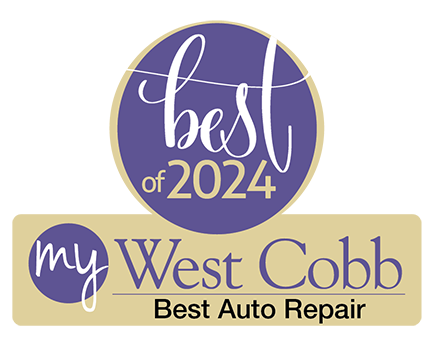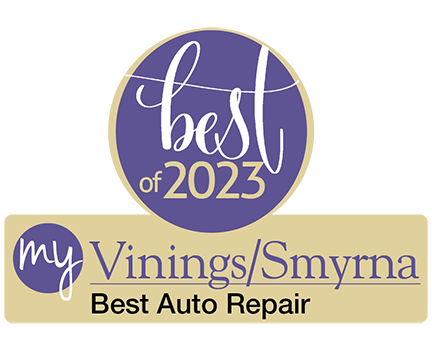How often should you change the oil in your car? It used to be that mechanics and car experts recommended you change the oil in your car every 3,000 miles or three months, whichever came first. While that was necessary with the vehicles of the past, modern cars are engineered to be more efficient and durable.
How Often Should You Change the Oil in Your Car?
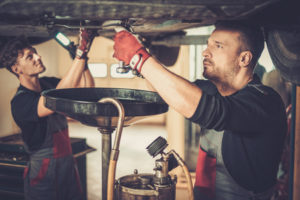 Not changing the oil in your car can cause the parts in the engine to wear down over time. It can also cause blockages in the passageways for the oil, which can lead to oil starvation and the engine components fusing together.
Not changing the oil in your car can cause the parts in the engine to wear down over time. It can also cause blockages in the passageways for the oil, which can lead to oil starvation and the engine components fusing together.
What it comes down to is the automaker’s recommendation. Each car company has a group of talented engineers who designed your car from the ground up, including the engine. They know better than anyone how often the oil should be changed. The owner’s manual will include your vehicle’s recommended oil change intervals. If you don’t have the manual, the automaker’s website will have the exact specifications.
How to Change Oil in a Car
Changing your own oil is a simple process. Before you start, gather the necessary supplies and tools:
- Motor Oil – be sure to get the proper grade for your car
- Oil Filter
- Socket Wrench
- Oil Filter Wrench
- Funnel
- Container to Catch the Oil
- Gloves
- Jack Stands
First, if the engine is cold, start it up and let it run for a few minutes to heat up the oil; otherwise some will stay trapped in the different nooks and crannies. Then, follow these instructions:
- Turn off the car and jack up the front end, supporting each side with jack stands.
- Remove the drain plug using the socket wrench. Be careful, because hot motor oil will come flowing out.
- Once the flow of oil slows to a drip, loosen the oil filter using the oil filter wrench. Before screwing on the new filter, rub some of the new oil on the rubber gasket, otherwise it could fuse to the engine and be almost impossible to remove.
- Replace and tighten the drain plug.
- From there, you need to remove the oil-filler cap on the top of the engine, place the funnel in the opening, and pour the oil inside. Clean up any spilled oil.
- Then, start the engine and let it run for a couple of minutes. Turn it off and check the oil level. If it’s low at all, add some more oil and repeat the process until the level is good.
You need to take the container of used motor oil to a recycling location, where it will be disposed of properly.
Can You Put Too Much Oil in a Car?
Yes, but not if it’s only a little too much. Filling the engine with an excessive amount of oil can cause serious damage to the engine due to foaming oil that doesn’t pump well. If the oil level on the dipstick is slightly above the maximum line, you should be okay.
This is why it’s best to follow the manufacturer’s recommendation for how much oil to use. If you have any question about the actual level in your car, start with less than you think you need, and add more. Adding more is far easier than having to drain excess oil from your car.
Signs of Low Oil in a Car
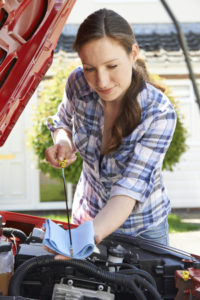 The main sign that your car is low on oil is when the oil pressure light comes on. It’s usually red and is in the gauge cluster, where you can’t miss it. If that happens, you need to pull over and add oil to the engine before continuing to run the car. When the light flickers, that means you need to add oil immediately, because it’s dangerously low.
The main sign that your car is low on oil is when the oil pressure light comes on. It’s usually red and is in the gauge cluster, where you can’t miss it. If that happens, you need to pull over and add oil to the engine before continuing to run the car. When the light flickers, that means you need to add oil immediately, because it’s dangerously low.
Another sign of low oil is if you check the dipstick and the level is low. You should be checking this periodically, ideally about once a month or more often if you have a higher-mileage car.
A noisy engine can indicate the oil level is low, as you hear the valves or bearings in a more pronounced manner. One of the worst signs is knocking. This can indicate you have only a few hundred feet before the engine seizes, so don’t ignore this one.
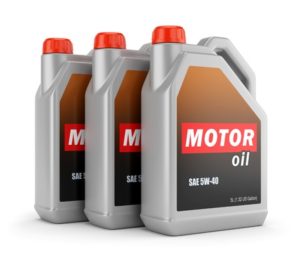 You need to know that the different letters and numbers on oil containers mean something. They indicate the grade or viscosity of oil, which is a measurement of its resistance to flow. The higher the viscosity, the slower it flows, like honey.
You need to know that the different letters and numbers on oil containers mean something. They indicate the grade or viscosity of oil, which is a measurement of its resistance to flow. The higher the viscosity, the slower it flows, like honey.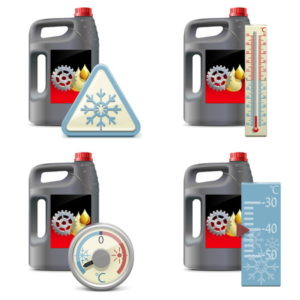 Your engine oil choices go beyond just grades. Likely, you’ve noticed there are quite a few types of oil: convention, synthetic, and high mileage to name a few.
Your engine oil choices go beyond just grades. Likely, you’ve noticed there are quite a few types of oil: convention, synthetic, and high mileage to name a few.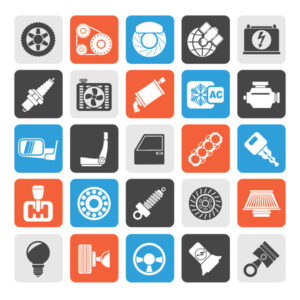 Any vehicle components that are made by a company other than the original manufacturer technically are aftermarket parts. In other words, if you can’t buy them from the dealership parts department, different components are aftermarket.
Any vehicle components that are made by a company other than the original manufacturer technically are aftermarket parts. In other words, if you can’t buy them from the dealership parts department, different components are aftermarket.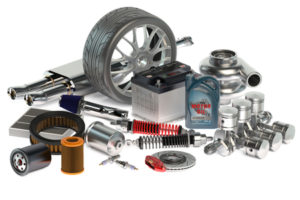 The assumption made by many people is that aftermarket parts are always cheaper than OEM options. That’s usually the case, but there are exceptions. If an aftermarket option is made far better, or is packed with more features, it could cost more. But the point of most aftermarket components is they help you save money by cutting costs.
The assumption made by many people is that aftermarket parts are always cheaper than OEM options. That’s usually the case, but there are exceptions. If an aftermarket option is made far better, or is packed with more features, it could cost more. But the point of most aftermarket components is they help you save money by cutting costs.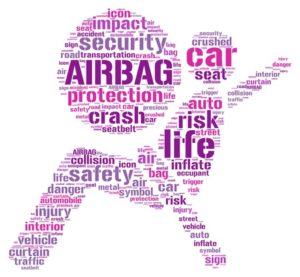 To understand why airbag maintenance is necessary, you need to have at least a basic understanding of how they work.
To understand why airbag maintenance is necessary, you need to have at least a basic understanding of how they work. Most vehicles have a diagnostic system for the airbags. If you see an SRS light come on, that means the airbag system is experiencing trouble and airbag maintenance may be required. You should have it inspected professionally right away, because the consequences of not following through could be severe.
Most vehicles have a diagnostic system for the airbags. If you see an SRS light come on, that means the airbag system is experiencing trouble and airbag maintenance may be required. You should have it inspected professionally right away, because the consequences of not following through could be severe.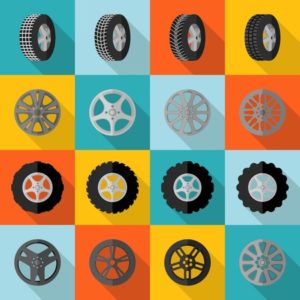 First off is the diameter, or the distance from one edge of the wheel across the face or front, to the opposite edge.
First off is the diameter, or the distance from one edge of the wheel across the face or front, to the opposite edge.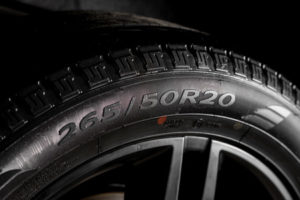 The first letter indicates the use of the tire (P for passenger car, LT for light truck, etc.). Some tires may not include this number.
The first letter indicates the use of the tire (P for passenger car, LT for light truck, etc.). Some tires may not include this number.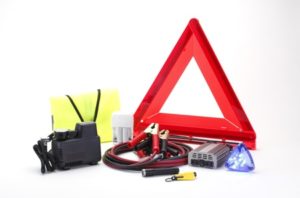 Flashlight: This is essential if you’re stranded in the dark, and so should absolutely be part of your car emergency kit contents. Sure, you could use your phone, but you’re also draining the battery, putting your ability to call for help in jeopardy. These days, there are plenty of compact, powerful and affordable flashlights on the market.
Flashlight: This is essential if you’re stranded in the dark, and so should absolutely be part of your car emergency kit contents. Sure, you could use your phone, but you’re also draining the battery, putting your ability to call for help in jeopardy. These days, there are plenty of compact, powerful and affordable flashlights on the market. Visibility brings up another issue. If you’re stranded on the side of the road, especially at night, it can be hard for motorists to see you.
Visibility brings up another issue. If you’re stranded on the side of the road, especially at night, it can be hard for motorists to see you. The first thing you want to do after ensuring you’re in secure spot is call on your phone for help. Atlanta has a service called HERO, which is run by the Georgia DOT Transportation Management Center. Just dial 511 on your phone for assistance. Know that the HERO service doesn’t include a tow truck, so you’ll have to call for one separately.
The first thing you want to do after ensuring you’re in secure spot is call on your phone for help. Atlanta has a service called HERO, which is run by the Georgia DOT Transportation Management Center. Just dial 511 on your phone for assistance. Know that the HERO service doesn’t include a tow truck, so you’ll have to call for one separately.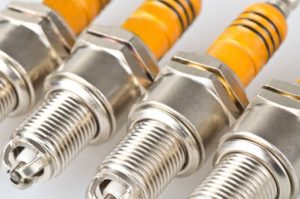 Spark plugs are small cylinders with a threaded end, kind of like a bolt. Each one sits at the top of your engine’s cylinders. If you have a V-6, there will be six spark plugs. If you have a four-cylinder, there will be four spark plugs.
Spark plugs are small cylinders with a threaded end, kind of like a bolt. Each one sits at the top of your engine’s cylinders. If you have a V-6, there will be six spark plugs. If you have a four-cylinder, there will be four spark plugs.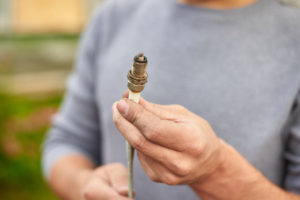 A few different symptoms can indicate that your spark plugs are dirty. Usually, people don’t notice these until there’s a big problem. One of the most common is if the engine is sluggish or not as powerful as it used to be. This can be coupled with diminished fuel economy, which you should be measuring at least once a month, if not each time you fill up with gas. Of course, modern cars often have a fuel mileage monitor, which is a huge help for keeping track.
A few different symptoms can indicate that your spark plugs are dirty. Usually, people don’t notice these until there’s a big problem. One of the most common is if the engine is sluggish or not as powerful as it used to be. This can be coupled with diminished fuel economy, which you should be measuring at least once a month, if not each time you fill up with gas. Of course, modern cars often have a fuel mileage monitor, which is a huge help for keeping track.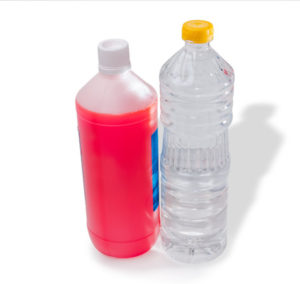 Antifreeze is normally made of propylene glycol or ethylene glycol. Like the name indicates, it doesn’t freeze easily. And unlike water, it doesn’t boil easily. Overheating engines can literally melt, so using antifreeze is essential.
Antifreeze is normally made of propylene glycol or ethylene glycol. Like the name indicates, it doesn’t freeze easily. And unlike water, it doesn’t boil easily. Overheating engines can literally melt, so using antifreeze is essential. You really should be checking the coolant level in your car at least once a month, along with the other liquids. Modern vehicles come with an overflow reservoir for the cooling system, where coolant flows into and out of as a way to release heat.
You really should be checking the coolant level in your car at least once a month, along with the other liquids. Modern vehicles come with an overflow reservoir for the cooling system, where coolant flows into and out of as a way to release heat.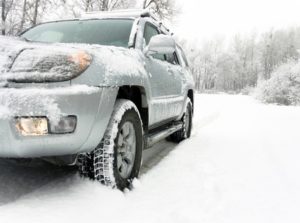 The biggest thing you need to contend with during the winter here is ice. Driving on ice safely is possible, but you need to be prepared and armed with solid information. First, realize you cannot stop quickly, so speed up and slow down gradually. You should also go under the speed limit, which was set with dry conditions in mind.
The biggest thing you need to contend with during the winter here is ice. Driving on ice safely is possible, but you need to be prepared and armed with solid information. First, realize you cannot stop quickly, so speed up and slow down gradually. You should also go under the speed limit, which was set with dry conditions in mind. If you have to go out, always plan on trips taking longer. This means you should leave sooner so you’re not tempted to speed.
If you have to go out, always plan on trips taking longer. This means you should leave sooner so you’re not tempted to speed.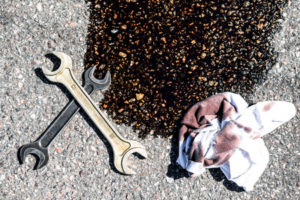 The big question you always need to be asking is how to tell if you have an oil leak or not. In all honesty, some cars (especially older ones) might burn some oil. Because of that fact, you can’t just judge based on the oil level. But you should be checking the oil at least once a month, if not sooner. On vehicles with a lot of miles, checking the oil every time you fill up the fuel tank is ideal.
The big question you always need to be asking is how to tell if you have an oil leak or not. In all honesty, some cars (especially older ones) might burn some oil. Because of that fact, you can’t just judge based on the oil level. But you should be checking the oil at least once a month, if not sooner. On vehicles with a lot of miles, checking the oil every time you fill up the fuel tank is ideal.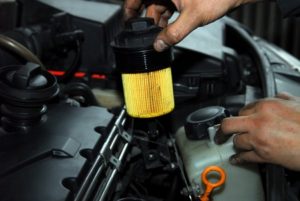 Sometimes, you may think your car is leaking oil but the problem is actually caused by oil filters that aren’t screwed on all the way. If you change your own oil, always apply some oil to the seal on the filter around the opening, and tighten it as much as possible by hand. If the filter is the source of a leak, you’ll see it’s soaked with oil just by climbing under the car. This is an easy fix.
Sometimes, you may think your car is leaking oil but the problem is actually caused by oil filters that aren’t screwed on all the way. If you change your own oil, always apply some oil to the seal on the filter around the opening, and tighten it as much as possible by hand. If the filter is the source of a leak, you’ll see it’s soaked with oil just by climbing under the car. This is an easy fix.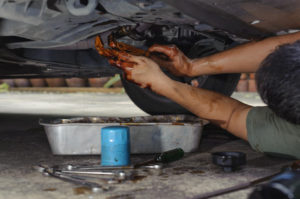 Once you’ve pinpointed the source of an engine oil leak, you can take steps to replace the faulty part that’s the source. Exactly how you go about this really depends on the component, your mechanical skills/experience and what vehicle you drive.
Once you’ve pinpointed the source of an engine oil leak, you can take steps to replace the faulty part that’s the source. Exactly how you go about this really depends on the component, your mechanical skills/experience and what vehicle you drive.



